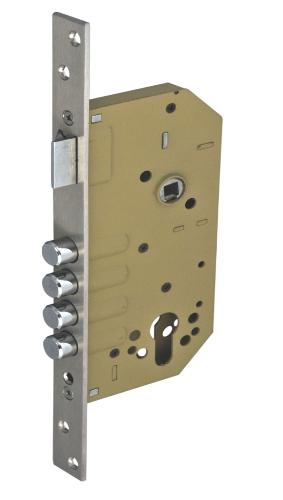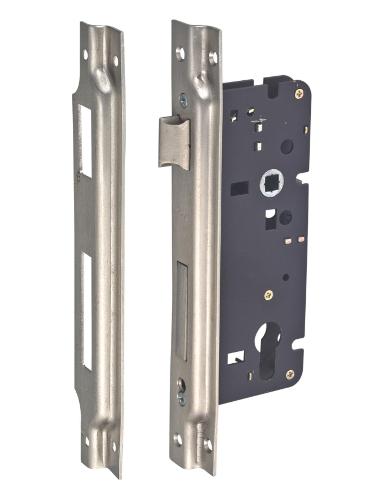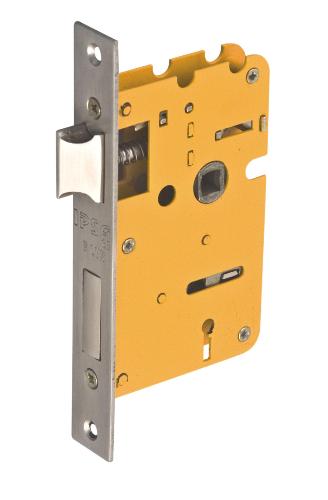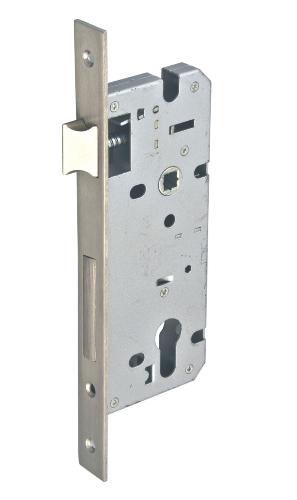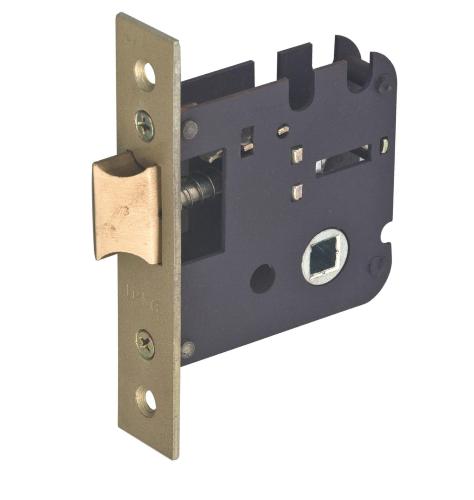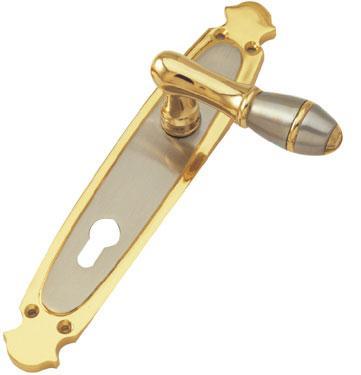Mortise Locks

What is Mortise Lock
Mortise Lock should be as per ISI: 2209- 1976. The metal case containing the operating parts of the lock set in to a mortise cut in the style of the door shutter is called mortise lock. This is the hidden lock only key hole is visible from outside. These are of two types i.e. Single cylinder lock and double cylinder lock.
- Single cylinder lock is operated with a key from the outside and without key from inside. But this have disadvantages that if any intruders come in the house through window etc. he can easily escape from the house by opening the lock.
- Double cylinder lock is operated both side with a key. Double cylinder locks offer better protection; if a burglar enters the house through a window, he or she cannot open the door without a key.
Mortise Lock Design
Mortise lock is a metal case containing the operating part of the lock is set in to a mortise cut in the style of the door. Locks for internal and external door, where security is consideration, consist of a latch bolt and a lock bolt. For internal doors in continuation use, the lock contains a latch bolt only to keep the door closed. They are horizontal mortise locks and vertical mortise locks.
The two bolt mortise lock consists of a case, a face, striking plate and lock assembly i.e. handle or knob, dead bolt and keys etc. The lock is made with a case plate that is screwed in the position flush with the edge of the door or finished with the face plate of brass which is free from any rivets to improve the aesthetic appeal.
Size of Mortise Locks
The size of lock is measured as overall length of the body from the outside face of the front to the rear end. The common sizes of mortise locks are 65, 75 and 100 mm. The clear depth of the body shall not be more than 35 mm. The lock is capable of being opened with key from both inside and outside.
Minimum thickness of shutter
When slot or recess for fixing mortise lock is prepared, sufficient thickness of shutter should be left on both side of slot to hold the lock properly and strength of shutter should not be reduced. As the thickness of mortise lock is 15 mm so keeping in view of this, the thickness of the shutter required for fitting the mortise lock should be less than 35mm.
Latch Bolt
Latch bolt should have minimum size12x16 mm for all sizes of locks. It consists of a latch bolt, latch spring follower. Follower has a square hole at the centre to accommodate the spindle of the handle, which operates the latch bolt. When the spindle with handle is inserted in to hole of follower and turned, the latch bolt should draw smoothly in to lock body. When fully pressed, the latch bolt should not project more than 1 mm from the face of fore end i.e. from face plate.
Striking Plate
The striking plate has two rectangular slots and it is fixed in the mortise cut of door frame in the alignment of the mortise lock (already fixed in shutter) to house or hold the locking bolt and latch bolt. The plate is termed as striking plate, as it serves the purpose of directing the shaped end of latch bolt in to the plate as the door is shut. It has two countersunk holes for fixing it to door frame.
Locking Bolt
Locking bolt is of 8x25 mm section for all sizes of locks. The minimum throw of the looking bolt should be 12mm. In the withdrawn position, it shall not be project more than 1 mm from the face of the fore end. The locking mechanism is ordinary lever type with not less than two levers. The action of the locking bolt when operated by key, should be smooth and without impediment and it should be positively locked in the forwarded position after completion of the key rotation.
Mortise Latch (vertical type)
The latches should be as per (IS; 5930-1970) and be operated both from inside and outside. They are provided with a thumb turn knob fitted on the handle, in order to close the door from inside while the compartment is in use. Mortise latches are generally used on bathroom, W C doors and doors to private rooms and do not have the arrangement of key for locking. The locking bolt turns into locking position when the thumb turn knob is turned through 90 degree.
Door Handle for Mortise Lock (Vertical Type)
Door handle should be as per (IS; 4992-1995)for use with mortise locks either handle type or knob type. Door handle is normally of cast brass having 2mm thickness or brass or aluminum alloy sheet with 1.25mm in thickness. The connecting rod of made of milled steel shall fit correctly both in follower in the mortise lock and in the socket of the handle and shall work positively in combination with the follower. Edges of door handles should not sharp.
Mortise Lock Installation
To fix mortise lock in the door shutter frame is a skillful job so a skilled carpenter is required for this job otherwise there is a chances of breaking the style of door shutter. To make recess in the frame of shutter a mortising bit and router is used by the carpenter. The other method adopted by the carpenter is to make drilling into the door frame with a large drill bit and straightening the slot/ recess.
The mortise lock is then inserted into the frame of door shutter. After making correct position of lock, the face plate is installed over the lock similarly the striking plate is inserted into the door frame and level with the bolt. Key hole and other hole for door knob or handle is prepared/ drilled in the door shutter. The key and handle holes are prepared in both side i.e. in the inside and outside so that the lock is used both side.
Mortise Lock Operation
A mortise lock requires the use of a latch and handle/ knob system. The handle or door knob that one pulls or slide the latch bolt back and open the door. With the uses of key the locking bolt should positively be locked in the forwarded position after completion of the key rotation, otherwise the latch will slide back whenever the handle is pulled or turned. To set the dead bolt, most mortise locks require a simple twist of a knob inside. A cylindrical tumbler and key can be used to slide the bolt back from the outside.
; Kota stone flooring is a subtle blend of grandeur and luxury giving the interior and exterior a gorgeous look.......
Kota stone flooring is a subtle blend of grandeur and luxury giving the interior and exterior a gorgeous look.......
 To get maximum ventilation and natural light in your house, make sure the building is properly oriented. Orientation of building saves energy and provides comfortable living as well. This article tells you about various factors and benefits of building orientation.
To get maximum ventilation and natural light in your house, make sure the building is properly oriented. Orientation of building saves energy and provides comfortable living as well. This article tells you about various factors and benefits of building orientation.
 Preview some of the most impressive pictures of kitchen from GharExpert Gallery.
Preview some of the most impressive pictures of kitchen from GharExpert Gallery.
 A solid roof on building is very important for everybody living in the house. The roof should be constructed in a way that assures you great safety. Here are given details about different types of roofing.
A solid roof on building is very important for everybody living in the house. The roof should be constructed in a way that assures you great safety. Here are given details about different types of roofing.
 Frames of doors and windows are most important parts of your doors and windows. They are available in different size, height, width and shapes. Frames hold locks and hinges and support door and windows to shut and open easily. Here is what you need to know about different doors and windows frames.
Frames of doors and windows are most important parts of your doors and windows. They are available in different size, height, width and shapes. Frames hold locks and hinges and support door and windows to shut and open easily. Here is what you need to know about different doors and windows frames.

Mortise and Tenon joints on wood

Lock

Aluminium Door Locks

Brass Door Locks 2 in 1

Brass Double Lock Door

Brass Mortice Single Door Lock

Brass Rim Lock

Cam Lock

Cupboard and Drawer Lock

Front Mont Multi Drawer Lock

Furniture Lock

Furniture Lock 2

Furniture Lock 3

Furniture Lock 4

Lock

Lock 2

Lock 3

Mortice Lock

Multipurpose Lock

Pad Lock

Hidden Lock
1.5 EXPANDABLE SHOWER HOSE ,EPDM TUBE , SS DOUBLE LOCK COVERIN

Lock
Door lock

Mortise and Tenon joints on wood

Joint Lock in Door
